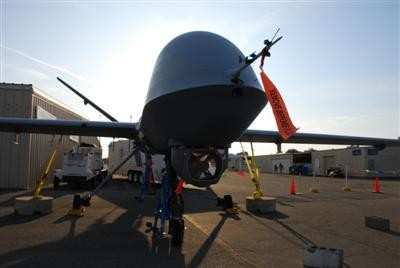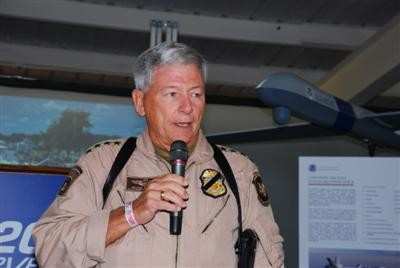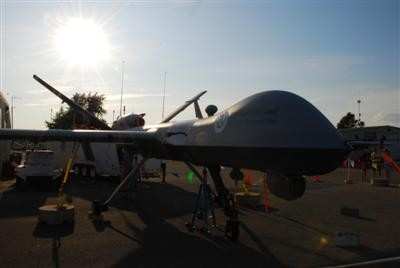Illegal Aliens VS Predator
By Chris Batcheller
For the last four years the U.S. Customs and Border Patrol
Office has been operating the Predator MQ-9 Unmanned Aerial System
(UAS) in the national airspace system. The topic of operating
unmanned vehicles in the national airspace system (NAS) has raised
many questions. Today the CPB Assistant Commissioner Michael
Kostelnik announced today that the office has brought the MQ-9
Predator B Unmanned Aerial System (UAS) to display at Oshkosh. The
CBP decided to bring the MQ-9 Predator to the annual air show so
that pilots could see the physical size of the air vehicle and talk
about their operations in the NAS.

Kostelnik said that the office has a model of the Predator
that it often has on display in their booth. Because some unmanned
vehicles are the same size as the model, some visitors confused the
models size with the real vehicle. They assumed that the model on
display was the same size as the real Predator. “I can
understand that people would be very concerned if we were flying
many small vehicles” he said. The model has approximately a 7
foot wing span, where the real Predator has a wingspan of 64
feet!
The MQ-9 on display is a much larger and more powerful version
of the older MQ-1 Predator. The MQ-1 was powered by a 115 hp piston
engine where the MQ-9 is powered with a 950 shaft horse power
turboprop engine. The MQ-9 can carry roughly 3,000 lbs of payload
and fly up to 52,000 feet.
Unlike a manned aircraft the MQ-9 Predator operates as a system.
Supporting any one MQ-9 will be a pilot, sensor operator,
intelligence officers, legal officers and other team members.
Having a team allows the CBP to the MQ-9 asset very effectively.
Not only will the vehicles support their normal missions, but they
will also assist in times of natural disaster such as hurricanes
and floods. The Assistant Commissioner said that the Predator
“doesn’t replace agents, but it makes them more
effective”.

CBP Assistant Commissioner
Kostelnik
The aircraft are always flown IFR. They can fly 20 hours
unrefueled, limiting the numbers of takeoffs and landings required.
They typically fly at 19,000 to 20,000 feet and operate from
military bases. Because they loiter at IFR altitudes and because
they spend very little time at airport environments, Kostelnik
said they pose little threat to manned aircraft. He also
noted that the agency operates a command center that has all the
radar feeds in the United States and Canada. He noted that agents
monitor the radars when the Predators are operational.

The agency operates 280 aircraft and 200 boats with 75
operations to complete their border patrol mission. That mission is
immigration, drug interdiction and other illegal activities. The
Assistant Commissioner said that the operations are not
“military, but special operations” and that their
mission is law enforcement and they must operate as such.
In addition to the MQ-9 Predator, the BCP operates Citation Jets
and P-3 Orion aircraft. The agency currently has two aircraft in
production as maritime aircraft. These aircraft will be outfitted
with different radios and some other modifications. They will be
stationed at coastal bases and will be used to support the BCP
mission.
 Aero-News: Quote of the Day (08.28.25)
Aero-News: Quote of the Day (08.28.25) ANN's Daily Aero-Linx (08.28.25)
ANN's Daily Aero-Linx (08.28.25) Classic Klyde Morris (08.25.25)
Classic Klyde Morris (08.25.25) Airborne 08.25.25: Zenith Homecoming, VP Racing, Affordable Flying Expo 2025
Airborne 08.25.25: Zenith Homecoming, VP Racing, Affordable Flying Expo 2025 Airborne 08.22.25: ARC Spinoff, Nat'l Championship Air Races, Hawkins Accident
Airborne 08.22.25: ARC Spinoff, Nat'l Championship Air Races, Hawkins Accident





